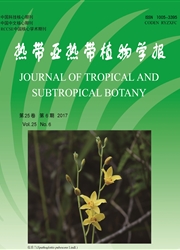

 中文摘要:
中文摘要:
研究华南热带多雨地区小良人工森林生态系统定位站不同人工林的碳固持特征,测定了林地表土有机碳含量、有机碳随土层深度的变化以及有机碳在不同粒级团聚体上的分布。结果表明:无植被覆盖的光裸地储存了极低水平的有机碳,在光裸地上种植桉树林后,如果地表枯落物长期人为取走,则土壤有机碳积累大大低于未受干扰桉林。当桉林进一步改造为阔叶混交林后,30-40a林龄混交林土壤有机碳含量均高于16.5gkg^-1,但仍只有邻近天然林土壤有机碳水平的76%,因而,这些人工混交林土壤具有进一步积累碳的潜力。光裸地在1m剖面上的含碳量均极低,并无显著的深度变化,约2-3gkg^-1,未保护的桉林含量水平在4-5gkg^-1,同样表土与心土层没有明显差别,通过地表输入的凋落物对土壤有机碳的影响主要集中在表层0.5m范围内。以豹皮樟Litsea rotundifolia,阴香Cinnamomum burmanni,潺槁木姜子Litsea glutinosa,陈氏钓樟Lindera chuni等为优势种的混交林,深层土壤含碳量显著高于其它混交林,并与村边林相似。土壤有机碳储量与土壤团聚体发育有一定的相关性,非水稳性团聚体以最小粒径(〈0.25mm)的含碳浓度最高,其它粒级的有机碳浓度相似,未成熟人工林,小团聚体的碳浓度较高,成熟林则在不同粒级中较均匀地分配有机碳,但实际碳储量于最大粒级的非水稳性团聚体中最多。成熟森林土壤水稳性团聚体含碳浓度大大高于非水稳性团聚体,水稳性团聚体在0.25-0.5mm及0.5-1.0mm两个粒级上有最大的碳积累量。结果表明,建立特定类型的混交林是增加林地碳汇功能的一个有效途径,非水稳性的大团聚体与水稳性的小团聚体的有效发育可能是成熟森林高固碳量的重要机理。
 英文摘要:
英文摘要:
Carbon sequestration in plantation soils was studied in tropical region of south China. Barren land without vegetation cover had a low level of TOC (2.79 g kg^-1). Establishment of eucalyptus plantation on barren land significantly increased TOC into a level of 14.16 g kg^-1, but only 6.12 g kg^-1 if litter was frequently removed by villagers. Replacement of eucalyptus with mixed broad-leaf forest further increased TOC to a level higher than 16.5 g kg^-1, which, however, was only 76% of TOC of nearby natural forest. TOC content of barren land did not changes across 1 m profile and kept at a level of 2-3 g kg^-1. Unchanged soil TOC content across 1 m profile was also found in eucalyptus plantation (at 4-5 g kg^-1). Litterfall exerted influence on TOC only within the uppermost 0.5 mof soil. A mixed plantation dominated by Litsea rotundifolia, Cinnamomum burmanni, Litsea glutinosa, Lindera chuni had much higher TOC in deep soil than other plantations, similar to that of nearby secondary natural forest. Soil aggregates played an important role in carbon sequestration. Water-unstable aggregates contained highest carbon in the smallest diameter class (〈0.25 mm). Other aggregates had similar levels of carbon content. For mature natural forest, carbon content of all diameter classes was similar to each other. Total carbon sequestration was highest in the largest class (〉 10 mm) due to well developed water-unstable aggregates. In contrast, highest carbon sequestration in water stable aggregates was found in two smallest clusses (0.25-0.5 mm and 0.5-1.0 mm). The results suggested that the establishment of targeted plantation would significantly enhance soil carbon sequestration in a short time. We considered that the high soil carbon sequestration of mature natural forest might be attributed to the well developed water unstable big aggregates and water stable small aggregates.
 同期刊论文项目
同期刊论文项目
 同项目期刊论文
同项目期刊论文
 Health risk from heavy metals via consumption of food crops in the vicinity of Dabaoshan mine, South
Health risk from heavy metals via consumption of food crops in the vicinity of Dabaoshan mine, South Effects of root diameter and root nitrogen concentration on in situ root respiration among different
Effects of root diameter and root nitrogen concentration on in situ root respiration among different Effects of nitrogen-fixing and non-nitrogen-fixing tree species on soil properties and nitrogen tran
Effects of nitrogen-fixing and non-nitrogen-fixing tree species on soil properties and nitrogen tran Responses of photosynthetic parameters of Mikania micrantha and Chromolaena odorata to contrasting i
Responses of photosynthetic parameters of Mikania micrantha and Chromolaena odorata to contrasting i Structural and physiological responses of two invasive weeds, Mikania micrantha and Chromolaena odor
Structural and physiological responses of two invasive weeds, Mikania micrantha and Chromolaena odor Allelopathic effects of eucalyptus and the establishment of mixed stands of eucalyptus and native sp
Allelopathic effects of eucalyptus and the establishment of mixed stands of eucalyptus and native sp Stand level estimation of root respiration for two subtropical plantations based on in situ measurem
Stand level estimation of root respiration for two subtropical plantations based on in situ measurem Photosynthesis, chlorophyll fluorescence, and antioxidant enzymes responses of invasive weed Mikania
Photosynthesis, chlorophyll fluorescence, and antioxidant enzymes responses of invasive weed Mikania 期刊信息
期刊信息
